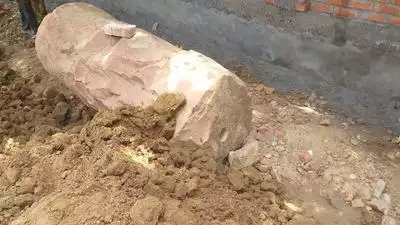Medieval Sugarcane crusher Found in Northern India
The archaeology department of Aligarh Muslim University (AMU) has excavated a “stone sugarcane crusher” of the late medieval period.
AGRA, INDIA—The Times of India reports that a stone sugar mill has been unearthed on farmland in northern India.

Manvendra Kumar Pundhir of Aligarh Muslim University said medieval sugar mills were comprised of a mortar and pestle to crush sugarcane and extract sugarcane juice.
The recovered piece of this mill measures about 12 feet long and about eight and one-half feet in diameter. Geared sugar rolling mills came into use in the seventeenth century.
According to Prof Manvendra Kumar Pundhir of AMU’s history department, the huge stone object was unearthed during the excavation of agricultural land in Dhanipur village in the district.
“The stone object appeared to be a stone sugar mill or a sugarcane crusher. The length of the discovered object is approx. 3.75 meters and its diameter is 2.6 meters.
During the medieval period, sugarcane crushers were made of two parts – mortar and pestle. Indians knew the art of extracting sugarcane juice to make jaggery and sugar since ancient times,” he explained.
He said that the sugar industry progressed greatly in medieval India.
Irfan Habib, professor emeritus, AMU, has written in his Economic History of Medieval India (1200 A.D.-1500 A.D.), that “Sugar mills appeared in India shortly before the Mughal era.
Evidence for the use of a drawbar for sugar-milling appears at Delhi in 1540, but may also date back earlier, and was mainly used in the northern Indian sub-continent.
Geared sugar rolling mills first appeared in Mughal India, using the principle of rollers as well as worm gearing, by the 17th century.”
Abul Fazl in his Ain-e-Akbari describes various techniques used in Mughal-era karkhanas (workshops).
One of them was the gear mechanism, which enabled the conversion of circular motion in vertical and was used in water-lifting devices, the sugarcane industry, and the oil pressing industry. IANS





